Current Discussion in UNFCCC and other international framework
Article 6 of the Paris Agreement
What is the Paris Agreement?
197 countries/regions are members of the United Nations Framework Convention on Climate Change (UNFCCC) which stipulates the principles of climate change countermeasures and each year, they discuss detailed rules of implementation at the Conference of the Parties (COP). The Paris Agreement was adopted at the COP21 held in Paris, France in 2015, as a new international framework for the reduction of greenhouse gas (GHG) emissions beyond 2020.
The Paris Agreement stipulates that all Parties including major emitting countries shall submit and revise their GHG emissions reduction target every 5 years, report their implementation status through a common and flexible manner, and receive reviews as well. Moreover, international cooperation including the Joint Crediting Mechanism (JCM) was articulated in Article 6 of the Agreement.
The Paris Agreement entered into force on 4 November 2016, when a threshold of 55 Parties to the Convention covering at least 55% of the total global greenhouse gas emissions ratified the agreement. In Japan, the Cabinet approved the conclusion of the Paris Agreement on 6 November 2016 and Japan deposited the acceptance letter of the “Paris Agreement” at the United Nations Headquarters to the Secretary- General of the United Nations. As of April 2021, 191 Parties have ratified the Agreement.
Various approaches, including opportunities for using markets, have been discussed at UNFCCC negotiations since COP13 held in Bali, Indonesia. Efforts over 8 years of discussions have resulted in Article 6 of the Paris Agreement, which includes all the elements proposed by Parties, such as top-down/bottom-up approaches, and market mechanisms/non-market approaches. At the COP26 held in Glasgow, United Kingdom in 2021, rules of markets mechanisms under Article 6 of the Paris Agreement were adopted as a part of the Glasgow climate pact.
Annex
Paris Agreement
Article 6
- Parties recognize that some Parties choose to pursue voluntary cooperation in the implementation of their nationally determined contributions to allow for higher ambition in their mitigation and adaptation actions and to promote sustainable development and environmental integrity.
- Parties shall, where engaging on a voluntary basis in cooperative approaches that involve the use of internationally transferred mitigation outcomes towards nationally determined contributions, promote sustainable development and ensure environmental integrity and transparency, including in governance, and shall apply robust accounting to ensure, inter alia, the avoidance of double counting, consistent with guidance adopted by the Conference of the Parties serving as the meeting of the Parties to this Agreement.
- The use of internationally transferred mitigation outcomes to achieve nationally determined contributions under this Agreement shall be voluntary and authorized by participating Parties.
- A mechanism to contribute to the mitigation of greenhouse gas emissions and support sustainable development is hereby established under the authority and guidance of the Conference of the Parties serving as the meeting of the Parties to this Agreement for use by Parties on a voluntary basis. It shall be supervised by a body designated by the Conference of the Parties serving as the meeting of the Parties to this Agreement, and shall aim:
- (a) To promote the mitigation of greenhouse gas emissions while fostering sustainable development;
- (b) To incentivize and facilitate participation in the mitigation of greenhouse gas emissions by public and private entities authorized by a Party;
- (c) To contribute to the reduction of emission levels in the host Party, which will benefit from mitigation activities resulting in emission reductions that can also be used by another Party to fulfil its nationally determined contribution; and
- (d) To deliver an overall mitigation in global emissions.
- Emission reductions resulting from the mechanism referred to in paragraph 4 of this Article shall not be used to demonstrate achievement of the host Party's nationally determined contribution if used by another Party to demonstrate achievement of its nationally determined contribution.
- The Conference of the Parties serving as the meeting of the Parties to this Agreement shall ensure that a share of the proceeds from activities under the mechanism referred to in paragraph 4 of this Article is used to cover administrative expenses as well as to assist developing country Parties that are particularly vulnerable to the adverse effects of climate change to meet the costs of adaptation.
- The Conference of the Parties serving as the meeting of the Parties to this Agreement shall adopt rules, modalities and procedures for the mechanism referred to in paragraph 4 of this Article at its first session.
- Parties recognize the importance of integrated, holistic and balanced non-market approaches being available to Parties to assist in the implementation of their nationally determined contributions, in the context of sustainable development and poverty eradication, in a coordinated and effective manner, including through, inter alia, mitigation, adaptation, finance, technology transfer and capacity-building, as appropriate. These approaches shall aim to:
- (a) Promote mitigation and adaptation ambition;
- (b) Enhance public and private sector participation in the implementation of nationally determined contributions; and
- (c) Enable opportunities for coordination across instruments and relevant institutional arrangements.
- A framework for non-market approaches to sustainable development is hereby defined to promote the non-market approaches referred to in paragraph 8 of this Article.
(Extracts from FCCC/CP/2015/10/Add.1)
Article 6.2: Cooperative approaches
Cooperative approaches are stipulated in Article 6.2 of the Paris Agreement, subject to the authorization of participating Parties, and it prescribes the use of emissions reduction/removals realized overseas to achieve emissions targets of each country. As one representative example of a cooperative approach, the JCM proposed and implemented by Japan, has been attracting great interest worldwide.
At the COP26 held in Glasgow, United Kingdom in 2021, rules of markets mechanisms under Article 6 of the Paris Agreement were adopted including ‘Guidance on cooperative approaches referred to in Article 6, paragraph 2, of the Paris Agreement’.
Overview of the Guidance on Article 6, paragraph 2 cooperative approaches
| 1. Internationally transferred mitigation outcomes (ITMOs) |
|---|
| Internationally transferred mitigation outcomes (ITMOs) from cooperative approach are emission reductions and removals generated from 2021 onward, and units of ITMOs are metric tonnes of carbon dioxide equivalent (tCO2-eq) or other non-GHG metrics. ITMOs are authorized by Parties participating in a cooperative approach for one of following three purposes of use: [1] Achievement of an NDC, [2] International mitigation purposes, and [3] Other purposes ([2] and [3] are referred to together as other international mitigation purposes.). Emission reduction generated by implementing Article 6, paragraph 4, activity (A6.4ER) authorized for use towards above three purposes are also ITMOs. |
| 2. Participation |
| Parties need to meet criteria for participating in a cooperative approach including having prepared, communicated and is maintaining an NDC, and having arrangements in place for authorizing the use of ITMOs and for tracking ITMOs. |
| 3. Corresponding adjustments |
| Corresponding adjustments to avoid double counting must be applied to all ITMOs. Since each Party has different type or metric of NDC target, appropriate method of corresponding adjustments in accordance with its NDC are applied. Party having a single-year NDC can choose from two methods: [1] providing an indicative multi-year emissions trajectory and annually applying corresponding adjustments, or [2] calculating the average annual amount of ITMOs used over the NDC implementation period, and annually applying indicative corresponding adjustments and applying corresponding adjustments at the end year of the NDC. Party having a multi-year NDC calculates multi-year emissions trajectory and annually applying corresponding adjustments. |
| 4. Reporting |
| Parties participating in a cooperative approach are required to provide three kinds of report/information: [1] Initial report, [2] Annual information, and [3] Regular information. In the Initial report, the Party needs to demonstrate that it fulfils the participation criteria, how it implements the cooperative approach, and how is ensures environmental integrity. The annual information is submitted annually with status of transfer and use of ITMOs. The regular information is submitted as an annex to the biennial transparency report (BTR), it contains information regarding status of cooperative approach implementation and NDC achievement. The submitted information excepting confidential information will be made publicly available on a centralized accounting and recorting platform. |
| 5. Review |
| The Article 6 technical expert review is to be undertaken for the information submitted by Parties. Report of the review will be made publicly available on the centralized accounting and recording platform. |
| 6. Recording and tracking |
| Necessary arrangements to be developed by participating Parties and the secretariat were defined in order to record and track ITMOs. Participating Parties need to have, or have access to, a registry for tracking ITMOs, and the secretariat will develop an international registry for participating Parties that do not have or do not have access to a registry. ‘Article 6 database’ to record and compile the annual and regular information submitted by participating Parties will be also developed. In addition, ‘Centralized accounting and reporting platform’ to support the Article 6 technical expert review will be developed. The international registry and the ‘Article 6 database’ will be developed as a part of this platform. |
| 7. Ambition in mitigation and adaptation actions |
| Participating Parties and stakeholders using cooperative approaches are strongly encouraged to commit to contribute adaptation and to deliver an overall mitigation in global emissions referred to in Article 6, paragraph 4. Regarding contributions to adaptation, particularly contributions to the Adaptation Fund is expected to be implemented. Regarding the overall mitigation in global emissions, it is expected to cancel ITMOs without any use purposes. Participating Parties need to report this information as part of their reporting on the regular information. |
Reference:
Guidance on cooperative approaches referred to in Article 6, paragraph 2, of the Paris Agreement
Article 6.4: The Mechanism
The establishment of a mechanism that contributes to the mitigation of GHG emissions and supports sustainable development under the authority and guidance of the CMA, is stipulated in Article 6.4. The Mechanism has several denominations among UNFCCC negotiators such as Sustainable Development Mechanism (SDM) or Sustainable Mitigation Mechanism (SMM).
At the COP26 held in Glasgow, United Kingdom in 2021, rules of markets mechanisms under Article 6 of the Paris Agreement was adopted including ‘Rules, modalities and procedures for the mechanism established by Article 6, paragraph 4, of the Paris Agreement’.
Overview of Rules, modalities and procedures for the Article 6, paragraph 4 mechanism
| 1. Definitions |
|---|
| An “Article 6, paragraph 4, activity” is an activity that meets the requirements of Article 6, paragraphs 4 ‒ 6, these rules, modalities and procedures, and any relevant decisions. Emission reduction issued for this activity is an “Article 6, paragraph 4, emission reduction” (A6.4ER). A6.4ER is measured in metric tonnes of carbon dioxide equivalent (tCO2-eq) or in other metrics. |
| 2. Role of the Conference of the Parties serving as the meeting of the Parties to the Paris Agreement |
| The CMA provides guidance to the Supervisory Body by taking decisions on rules of procedure of the Supervisory Body and on recommendations made by the Supervisory Body. |
| 3. Supervisory Body |
| The Supervisory Body supervises the Article 6.4 mechanism under the authority and guidance of the CMA. The Supervisory Body establish requirements and processes necessary to operate the mechanism and accredits operational entities as designated operational entities which assess registration of activities and issuance of credits. The Supervisory Body comprises 12 members and 12 alternate members. The members are elected from Parties to the Paris Agreement ensuring broad and equitable geographical representation. A term of each member is basically two years, and each member can serve up to two terms. |
| 4. Participation responsibilities |
| Host Parties of Article 6, paragraph 4 need to meet criteria including having prepared, communicated and is maintaining an NDC, and indicating how the activity contributes to the achievement of its NDC and to sustainable development. |
| 5. Article 6, paragraph 4, activity cycle |
| Definitions and criteria regarding following elements are defined as the Article 6, paragraph 4, activity cycle: A. Activity design, B. Methodologies, C. Approval and authorization, D. Validation, E. Registration, F. Monitoring, G. Verification and certification, H. Issuance, I. Renewal of the crediting period, J. First transfer from the mechanism registry, K. Voluntary cancellation, and L. Other processes associated with Article 6, paragraph 4, activities. |
| 6. Mechanism registry |
| The mechanism registry with functions to enable transfer and use of A6.4ER will be developed. The mechanism registry will be connected to the international registry referred to in Article 6 of the Guidance on Article 6, paragraph 2 cooperative approaches. |
| 7. Levy of share of proceeds for adaptation and administrative expenses |
| 5% of A6.4ERs is issued to an account held by the Adaptation Fund at its issuance as levy for the share of proceeds (SOP) to assist developing country Parties that are particularly vulnerable to the adverse effects of climate change to meet the costs of adaptation. |
| 8. Delivering overall mitigation in global emissions |
| 2% of the issued A6.4ERs is cancelled at its issuance to enhance the delivery of overall mitigation in global emissions referred to in Article 6, paragraph 4. |
| 9. Avoiding the use of emission reductions by more than one Party |
| In case that host Party has authorized A6.4ERs for use towards the achievement of NDCs, the host Party needs to apply a corresponding adjustment for the first transfer of the A6.4ERs. |
| 10. Use of emission reductions for other international mitigation purposes |
| In case that host Party has authorized A6.4ERs for use for other international mitigation purposes, the host Party needs to apply a corresponding adjustment for the first transfer of the A6.4ERs. |
| 11. Transition of CDM activities and use of CERs towards first NDC |
| Regarding transition of CDM activities, project activities and programmes of activities registered under the CDM meeting certain conditions can be registered as the Article 6, paragraph 4, activities. The conditions include that a request of transition is made by the end of 2023 and an approval for the transition is provided by the host Party by the end of 2025. Regarding CERs generated from the CDM, CERs meeting certain conditions can be used towards achievement of an NDC. The conditions include that the CERs are generated from CDM activities registered after 2013 and the CERs identified as pre-2021 emission reduction. |
Reference:
Article 6.8: Non-market approaches
Non-market approaches are stipulated in Article 6.8 as a framework of mitigation, adaptation, finance, technology transfer, and capacity building to achieve sustainable development.
Article 13: Transparency framework
Article 13 of the Paris Agreement established the Enhanced Transparency Framework for countries to report and share their progress of NDCs implementation. Each Party needs to submit a Biennial Transparency Report (BTR) once every two years to update GHG emissions and progress of NDC implementation, and the submitted report is reviewed.
At the COP24 held in Katowice, Poland in 2018, a set of rules of the enhanced transparency framework were adopted and items to be reported when Parties implement Article 6 of the Paris Agreement were defined. Particularly, when mitigation outcomes are internationally transferred under Article 6 (called ITMOs), those countries who transfer and acquire mitigation outcomes are mandated to implement corresponding adjustments on their GHG emission reporting. Furthermore, at the COP26 held in Glasgow, United Kingdom in 2021, more details of rules of the Enhanced Transparency Framework adopted at COP24 were adopted including common tabular formats of biennial transparency report (BTR). The common tabular formats contain columns for describe the transfer of ITMOs under cooperative approaches and application of corresponding adjustments.
Corresponding adjustments
Article 6, paragraph 2 of the Paris Agreement stipulates that Parties need to apply measures to avoid double counting of internationally transferred mitigation outcomes (ITMOs). In regard to rules of the Enhanced Transparency Framework adopted at COP24 it stipulates that more specific measures that Parties should apply for the international transfer of ITMOs. Furthermore, the Guidance on Article 6, paragraph 2 cooperative approaches adopted at COP26 defined methods of how to apply the adjustments in more detail.
<Authorization of ITMOS and corresponding adjustments>
It is necessary to apply corresponding adjustments to all ITMOs to avoid double counting. ITMOs can be originated from activities under Article 6, paragraph 2, cooperative approaches and from activities under Article 6, paragraph 4 mechanism. Mitigation outcomes generated from Article 6, paragraph 2, cooperative approaches become ITMOs on condition that Parties participating in cooperative approaches authorize the use of mitigation outcomes. Emissions reduction generated from Article 6, paragraph 4 mechanism (A6.4ER) become ITMOs on condition that a host Party authorize the use of emissions reduction. The authorized ITMOs can be used for three purposes: [1] Achievement of NDCs, [2] International mitigation purposes, and [3] Other mitigation purposes ([2] and [3] are referred together as other international mitigation purposes.). Mitigation outcomes without this authorization does not become ITMOs, and application of corresponding adjustments are not required.
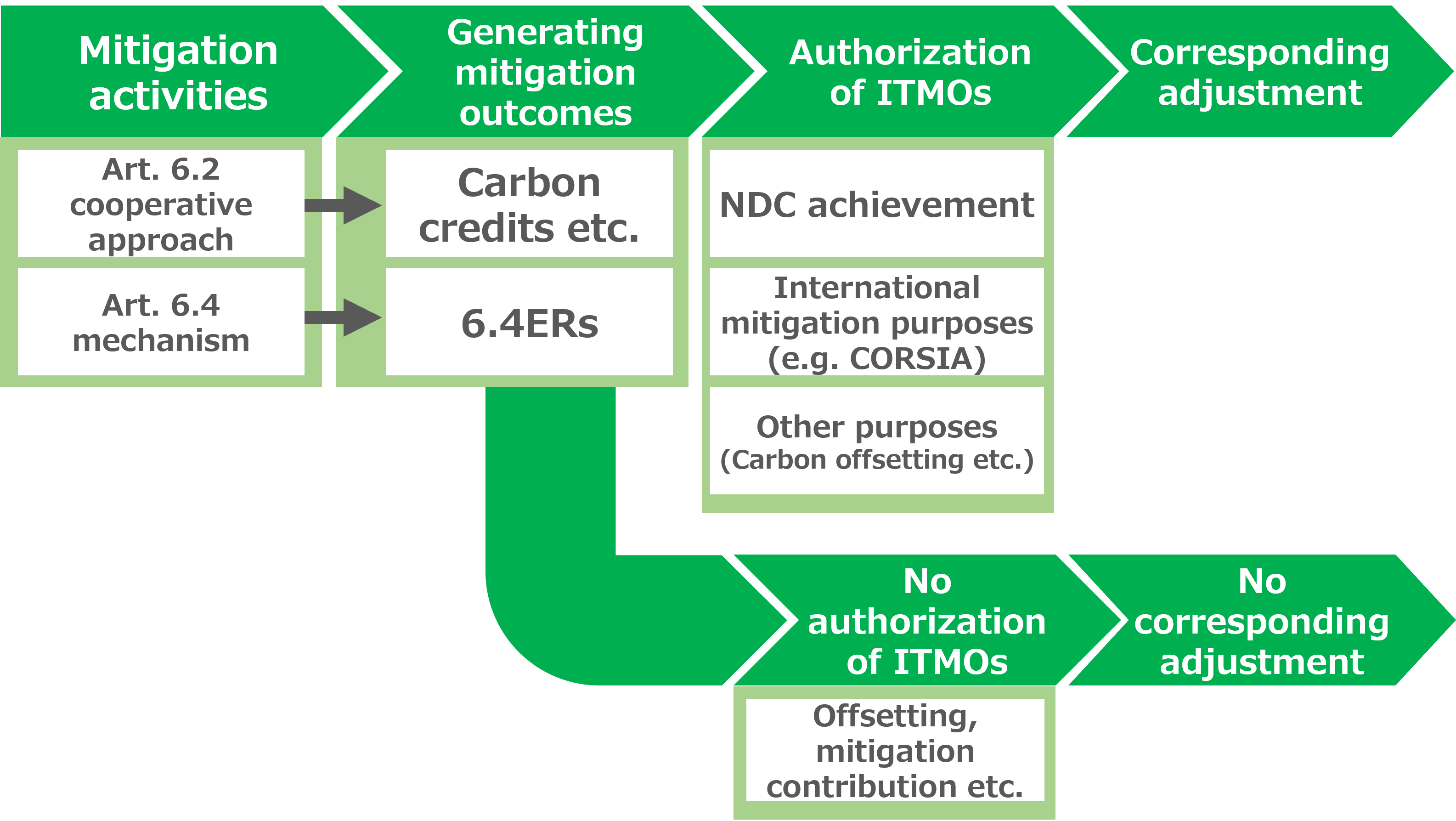
<Purpose of using ITMOs and application of corresponding adjustments>
*Units of ITMOs include metric tonnes of carbon dioxide equivalent (tCO2-eq) or other non-GHG metrics. The following is an explanation of the corresponding adjustments for the case where tCO2-eq metric are assumed.
When ITMOs are used towards the achievement of an NDC, a Party acquiring ITMOs subtracts the quantity of ITMOs acquired from its GHG emission and the Party transferring ITMOs adds the quantity of ITMOs on its GHG emissions.

An example of ITMOs used for international mitigation purposes is Carbon Offsetting and Reduction Scheme for International Aviation (CORSIA) in the international aviation sector. In case that ITMOs are used for international mitigation purposes to achieve reductions requirement of an airline operator, a Party transferring ITMOs adds the quantity of ITMOs on its GHG emissions.

In case that ITMOs are used for other mitigation purposes, it is assumed that ITMOs will be used for such as voluntary carbon offsetting or other types of usage and a Party transferring ITMOs adds the quantity of ITMOs on its GHG emissions.

In case that mitigation outcomes under Article 6.2 activities or Article 6.4 activities are not authorized as ITMOs, these mitigation outcomes are expected to be used for such as voluntary carbon offsetting or mitigation contribution, and a Party transferring ITMOs is not required to apply the corresponding adjustments.

<Methods of corresponding adjustments>
Since each Party has different type of NDC target in terms of single-year target or multi-year target, appropriate method of corresponding adjustments in accordance with its NDC are applied. When a Party has a single-year target it can choose from two methods: [1] providing an indicative multi-year emissions trajectory and annually applying corresponding adjustments (trajectory method’), or [2] calculating the average annual amount of ITMOs used over the NDC implementation period, and annually applying indicative corresponding adjustments (averaging method). In the case of Parties having a multi-year target the trajectory method will be applied and will apply corresponding adjustments annually (trajectory method).
Three patterns of corresponding adjustments applied to a Party transferring ITMOs and another Party acquiring ITMOs are shown below: [1] Having a multi-year target with applying the trajectory method, [2] Having a single-year target with applying the trajectory method, and [3] Having a single-year target with applying the averaging method.
| ITMOs transferring Party | ITMOs acquiring Party |
|---|---|
|
Annual amount of ITMOs transferred and its average during the NDC period  |
|
| [1] Having a multi-year target with applying the trajectory method | |
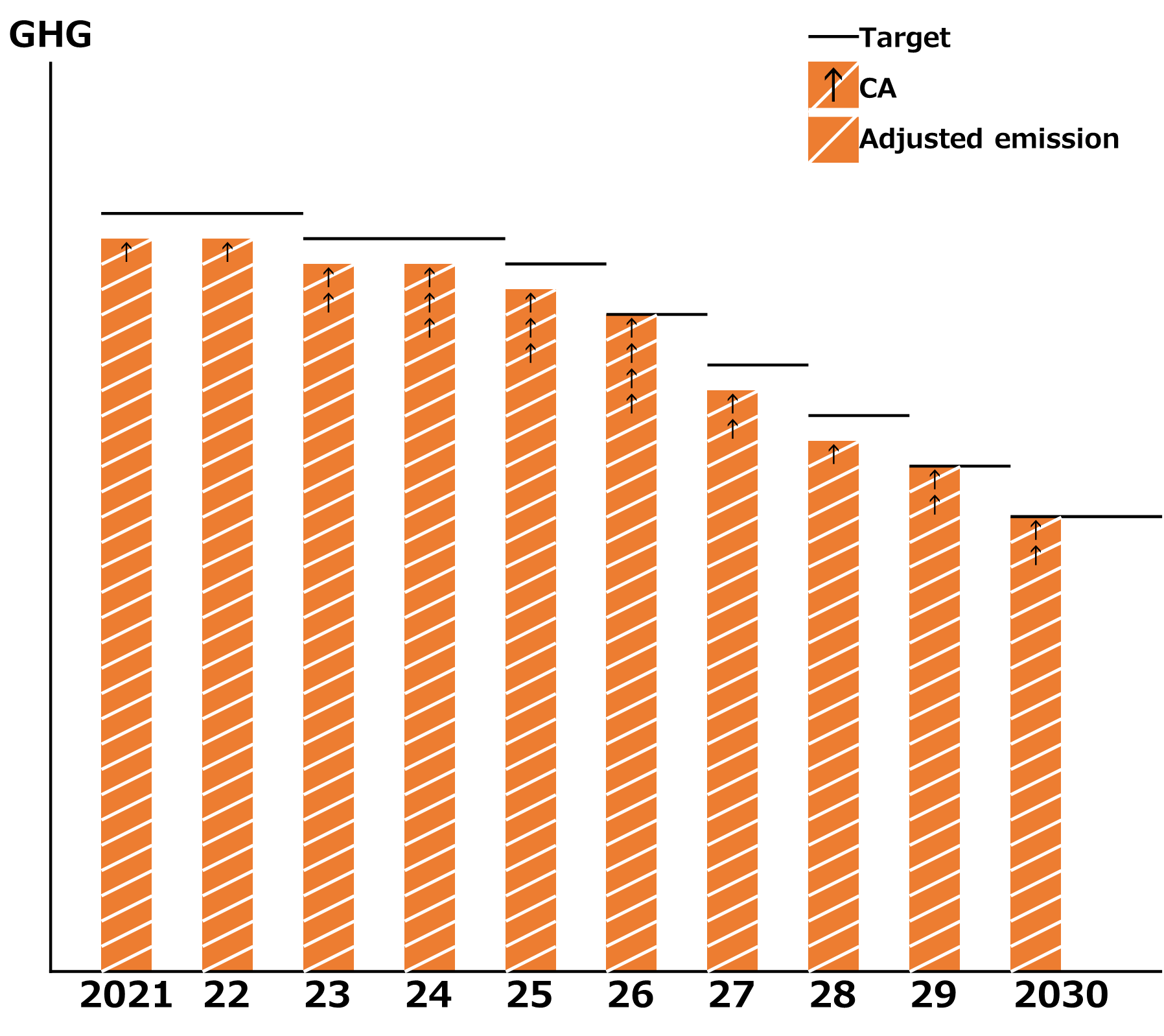 |
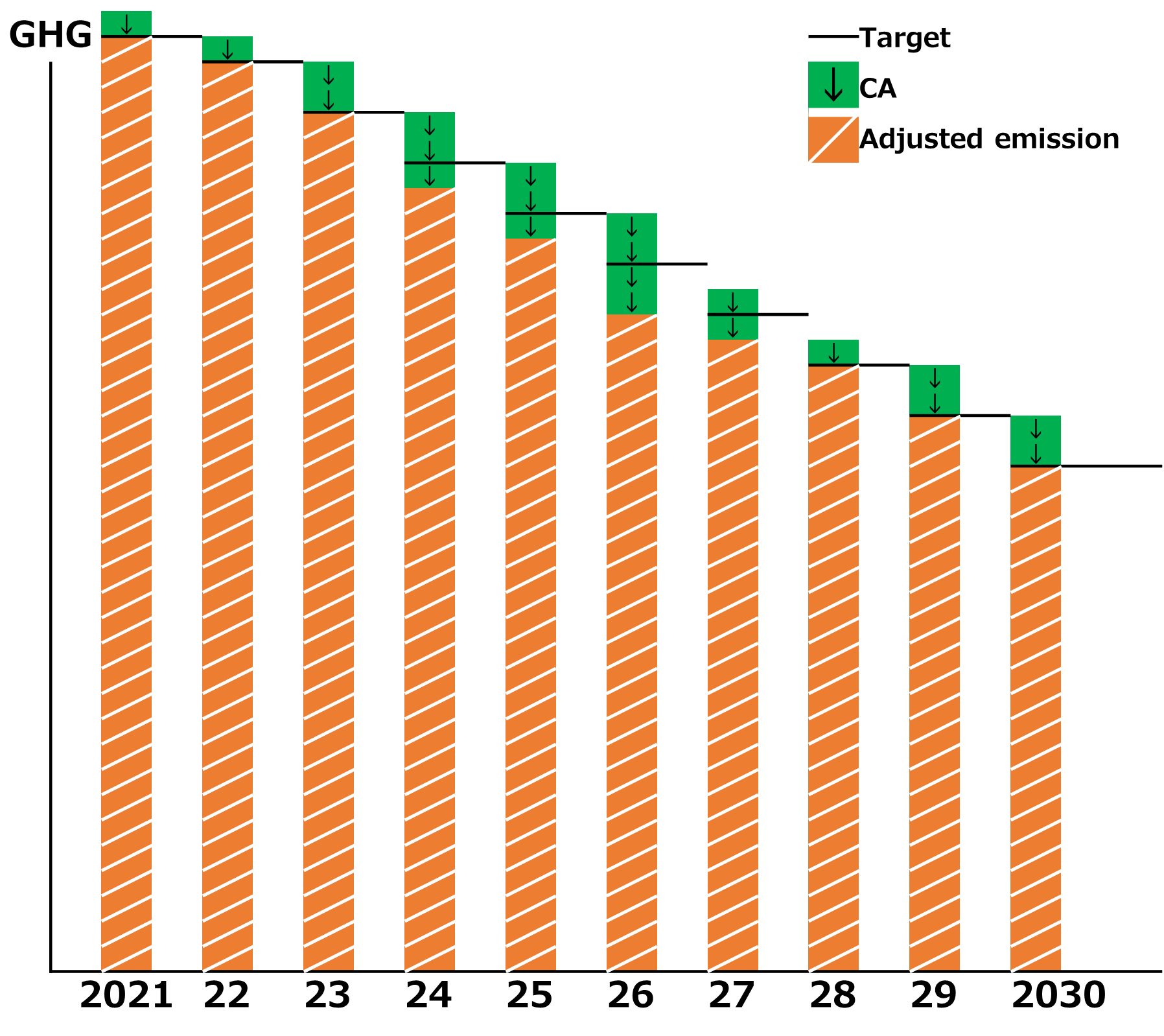 |
| [2] Having a single-year target with applying the trajectory method | |
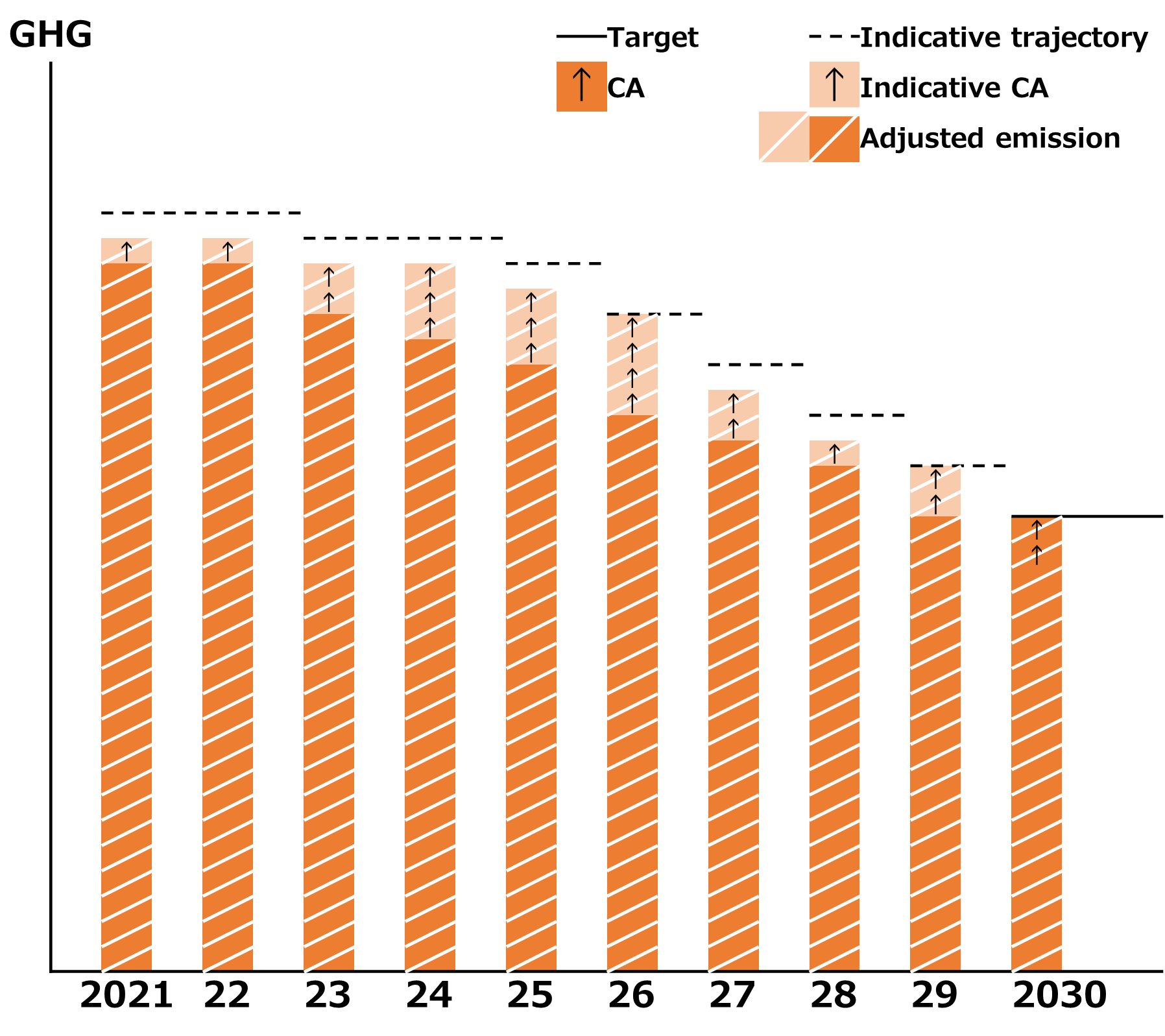 |
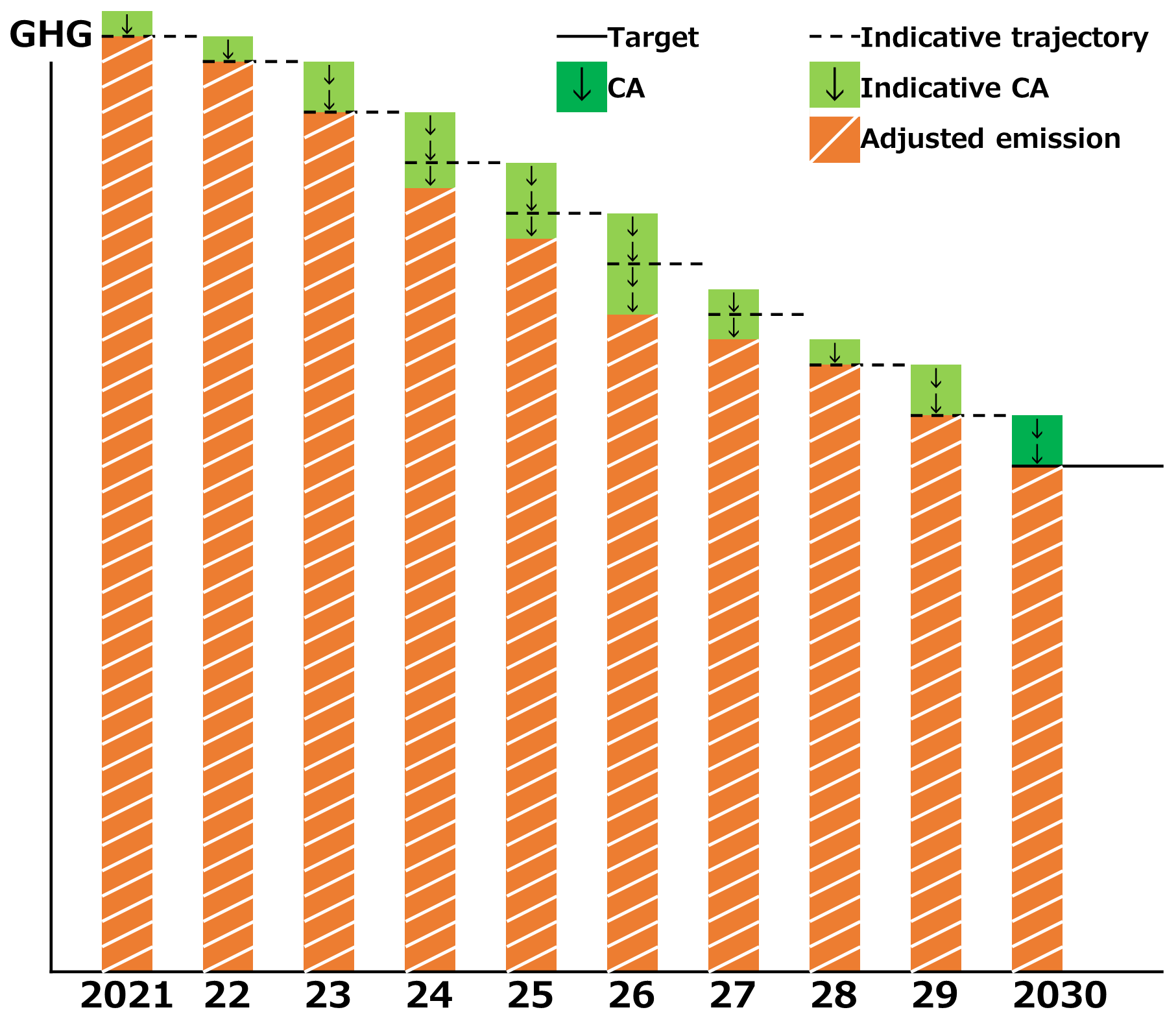 |
| [3] Having a single-year target with applying the averaging method | |
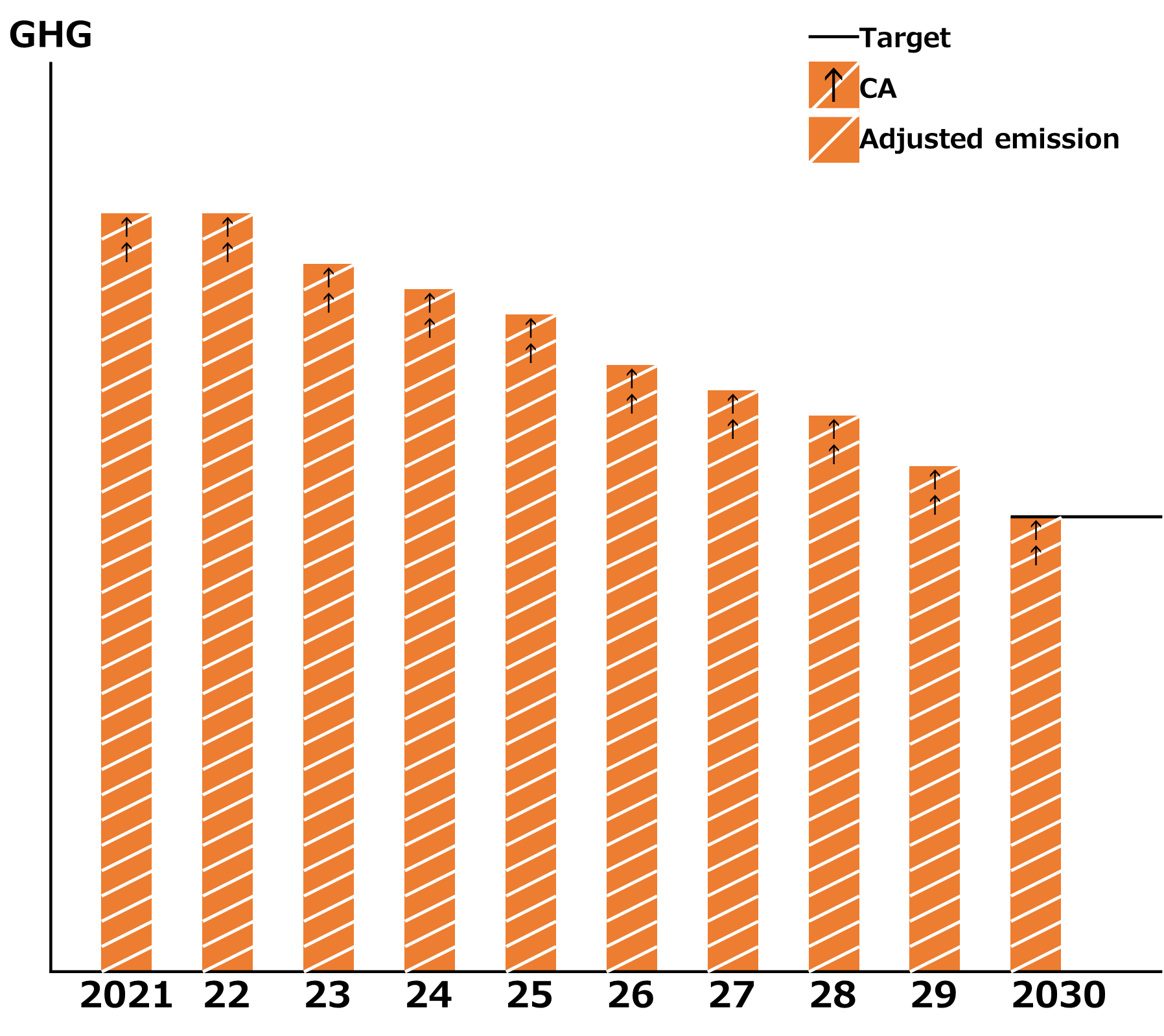 |
 |

